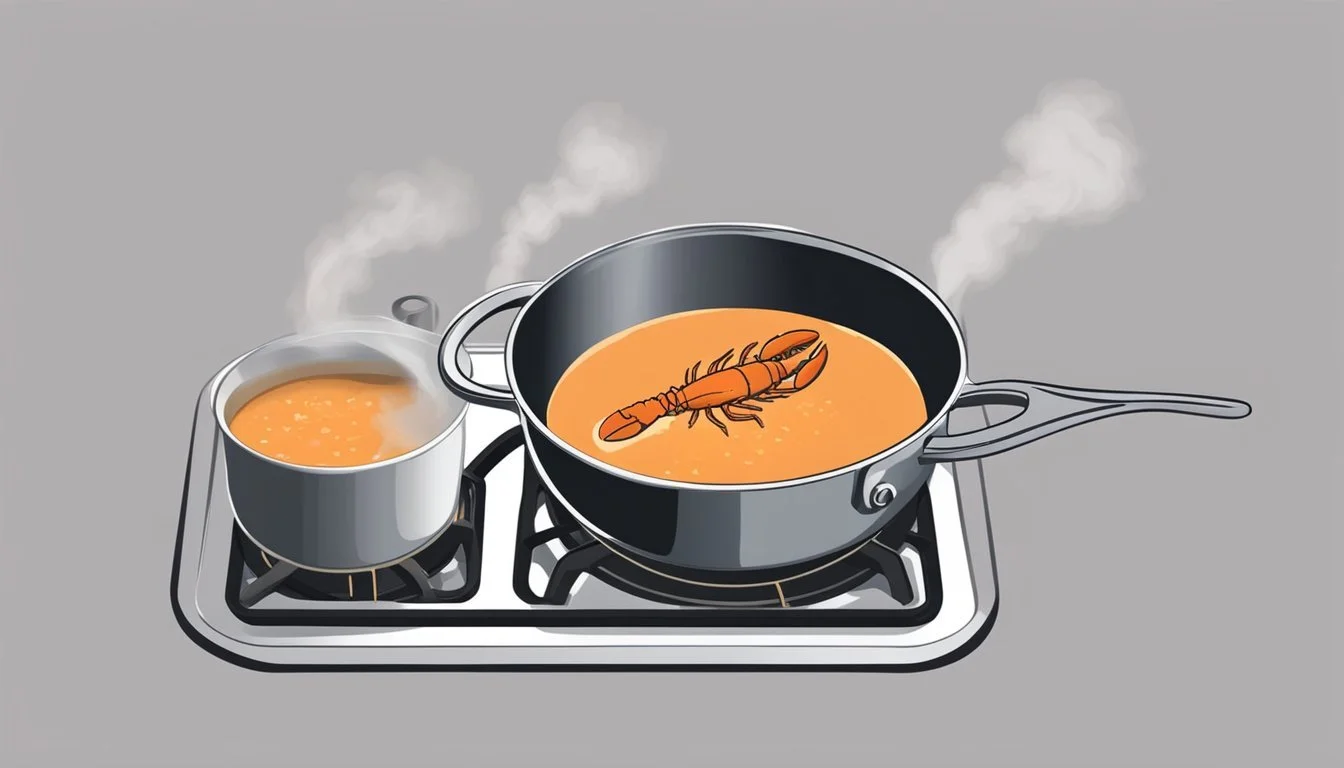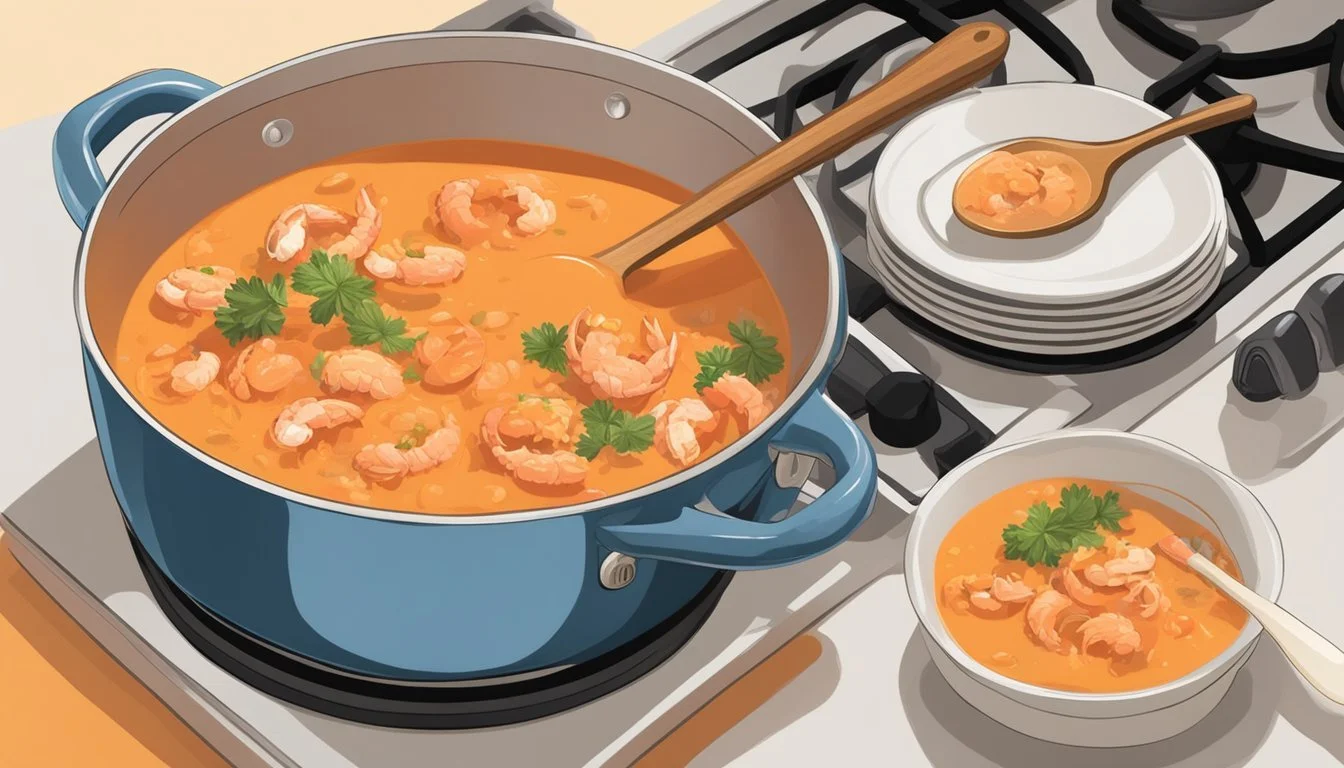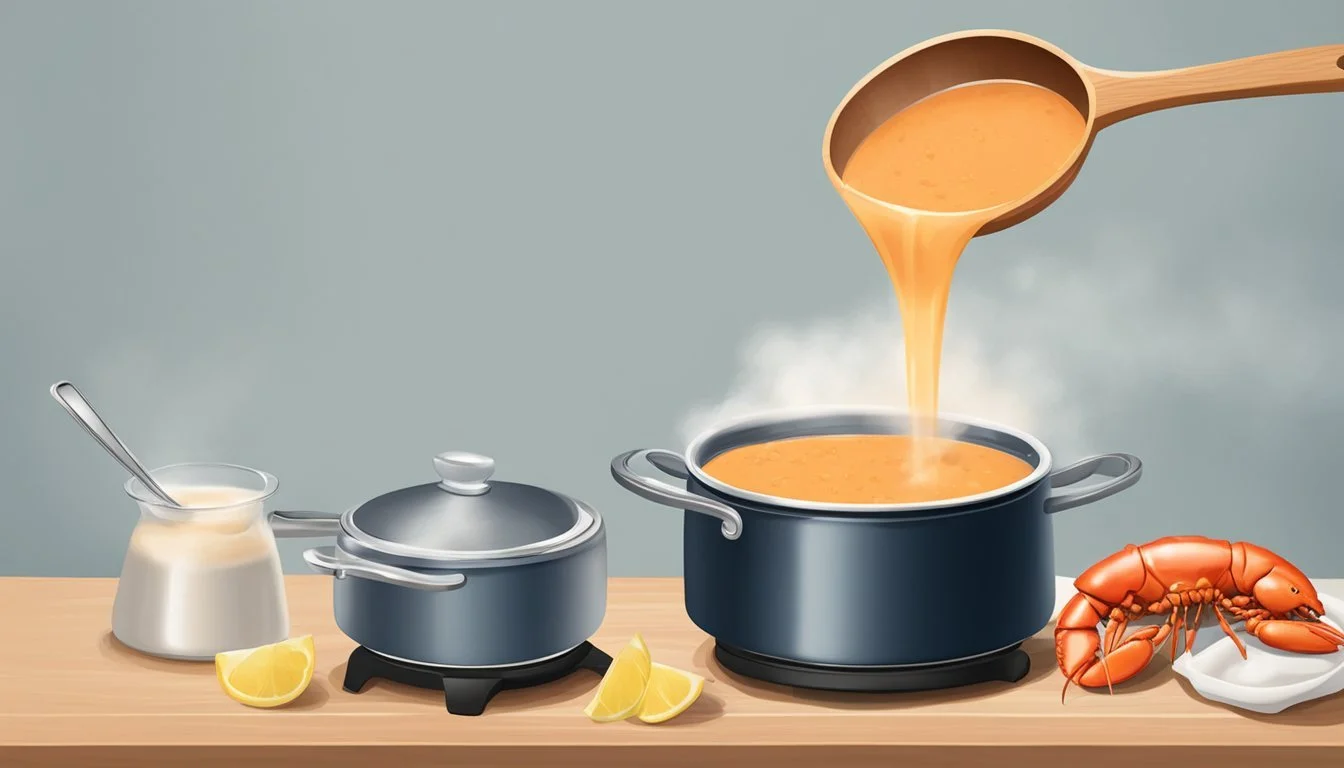Best Way to Reheat Lobster Bisque
Ensuring Optimal Creaminess
Lobster bisque is a delicate and indulgent dish renowned for its rich flavor and creamy texture. When properly reheated, it can capture the essence of a fresh batch, ensuring that none of its luxurious qualities are lost. Achieving this requires a gentle approach to preserve the lobster (What wine goes well with lobster?) bisque's creaminess and prevent any separation of the ingredients, which can occur if the bisque is subjected to high heat.
To retain the soup's velvety consistency, careful temperature control is essential. Warmth should be introduced gradually, allowing the bisque to reach the optimal temperature slowly. This method ensures that the flavors are enhanced rather than diminished, safeguarding the bisque's characteristic balance of seafood (What wine goes well with seafood?) and cream. The goal is to maintain the integrity of the bisque’s original taste and texture, allowing for a delightful culinary experience akin to its initial serving.
Methods such as stovetop reheating are generally preferred over microwave heating, as they provide a more uniform temperature distribution. The use of the right utensils, such as a wooden spoon or silicone spatula for stirring, also plays a vital role in maintaining the lobster bisque’s creaminess throughout the reheating process, as it helps to integrate all the components without inducing harsh movements that might disrupt the bisque's smooth consistency.
Understanding Lobster Bisque
Lobster bisque is a rich, creamy soup known for its deep flavor derived from the essence of lobster. This section explores the core elements of lobster bisque and underscores the critical nature of reheating it correctly to maintain its luxurious quality.
Components of Lobster Bisque
Lobster bisque begins with a stock made from lobster shells, which infuses the liquid with a seafood flavor that is both intense and foundational. The main ingredients typically include:
Lobster meat: The star component, providing succulent bites and characteristic taste.
Stock: A flavorful base crafted from simmered lobster shells and aromatics.
Cream and butter: These dairy products add a velvety texture and enrich the bisque.
Seasonings: A variety of herbs and spices enhance the overall taste profile.
A careful balance of these ingredients creates a bisque that is not only flavorful but also has a rich and creamy consistency.
Importance of Proper Reheating
Proper reheating is essential to preserve the bisque's creamy texture and prevent the dairy components from separating or curdling. The warming process should be:
Gentle: Employ low heat to avoid altering the bisque's delicate flavors.
Gradual: Slowly bring the temperature up, stirring occasionally to ensure even heating.
Understanding the value of these components and their sensitivity to heat ensures that the bisque's integrity is maintained throughout the reheating process.
Pre-Reheating Preparation
Proper pre-reheating preparation ensures the lobster bisque retains its creaminess during reheating. Key factors include the method of thawing if frozen, and ensuring the bisque has been stored correctly prior to reheating.
Thawing Frozen Bisque
If the lobster bisque is frozen, one should never rush the thawing process. To preserve the texture and flavor of the bisque, it is best thawed in the refrigerator for several hours or overnight. Thawing at a controlled, low temperature prevents the bisque from separating or becoming grainy.
Storing Lobster Bisque
For those who have refrigerated their lobster bisque, safe storage is essential to maintain its quality. The bisque should be stored in an airtight container to prevent contamination and flavor loss. An airtight seal also keeps the bisque from absorbing other flavors from the refrigerator, ensuring it remains as flavorful as when it was first made.
Reheating Techniques
Proper reheating maintains the lobster bisque's creaminess and the integrity of its flavors. It is important to control the heat and stir the bisque to prevent separation and scorching.
Stovetop Method
One can reheat lobster bisque on the stovetop by transferring the bisque into a saucepan. They should ensure that the saucepan is set over low heat, which allows the soup to warm evenly without boiling and risking degradation of the bisque's texture. The individual should occasionally stir the bisque using a wooden spoon or a silicone spatula to promote even heat distribution and prevent sticking to the bottom of the pan.
Oven Method
Reheating in an oven involves preheating the oven to a gentle temperature, typically around 350 degrees Fahrenheit, to rehearse the bisque without overheating. The bisque should be placed in an oven-safe dish, covered with aluminum foil to retain moisture, and placed on a baking pan or cookie sheet. It's crucial that the bisque is reheated until it's just warm to retain its delicate flavors.
Microwave Method
For a quicker option, one may use the microwave to reheat lobster bisque. It should be transferred into a microwave-safe bowl and covered with a lid or microwave-safe covering to contain moisture. The bisque should be microwaved on medium power and it's recommended to stir the bisque halfway through the reheating process to ensure even warming. Care must be taken to not overcook, as high power settings may alter the soup's luxurious texture.
Maintaining Creaminess and Flavor
When reheating lobster bisque, the primary goals are to preserve the soup's luxurious creaminess and its rich depth of flavor. Careful heating and seasoning techniques can help achieve this.
Avoiding Separation and Curdling
To prevent the bisque from separating or curdling, one should reheat it slowly over low heat. It is imperative to stir the bisque frequently to ensure even distribution of warmth and to maintain a smooth texture. The use of low heat is essential, as high temperatures can cause the proteins in cream to coagulate, leading to curdling. If the bisque has been frozen, it should be thawed in the refrigerator before reheating to prevent temperature shock which could also cause curdling.
A preventative strategy includes adding a small amount of heavy cream during the reheating process. The additional fat from the heavy cream can stabilize the bisque and help maintain its emulsion.
Seasoning Adjustments Post-Reheating
Once the bisque has reached the desired temperature, taste testing is essential to ensure the flavor profile is balanced. Reheating can dull the original seasonings; therefore, they may need a slight adjustment. Here is a simple guide for adjustments:
Salt and Pepper: Adjust these staples to enhance the bisque's overall flavor foundation.
Butter or Olive Oil: A small dollop of butter or a drizzle of olive oil can reintroduce richness to the bisque.
Garnish: Fresh garnishes like chopped herbs or a squeeze of lemon can brighten up the flavors just before serving.
It is important to add these adjustments incrementally and taste frequently.dling to prevent the loss of creaminess and to ensure a consistent and robust flavor.
Serving Suggestions and Accompaniments
Elevating lobster bisque involves thoughtful garnishing and pairing. The right garnish adds visual appeal and tasteful complexity, while an astute choice of accompaniment harmoniously complements the rich flavors of the bisque.
Proper Garnishing
Garnishes serve both an aesthetic and a flavor-enhancing role in lobster bisque. Tarragon is a classic choice, offering a slight anise-like flavor that complements the bisque without overpowering it.
Fresh Tarragon: Sprinkle finely chopped leaves atop the bisque just before serving.
Paprika: A light dusting can add a touch of sweetness and color.
These elements add layers of flavor and create an enticing presentation that invites diners to savor the bisque.
Perfect Pairings
Pairing lobster bisque with fitting side dishes can transform a simple meal into a symphony of flavors. One must consider the balance and how each component will interact with the creamy and decadent nature of the bisque.
Crusty Bread: Ideal for soaking up the rich flavors, a slice of freshly baked bread complements the creamy texture.
Salad: A crisp, green salad dressed with a bright vinaigrette contrasts the richness and cleanses the palate.
Lobster Roll: For a heartier meal, a classic lobster roll provides a satisfying balance, combining the same protein in a different texture and flavor profile.
Selecting the right accompaniments ensures each bite is harmonious and elevates the overall dining experience.
Additional Tips and Tricks
When reheating lobster bisque or handling cooked lobster meat, maintaining the integrity of the seafood's texture and flavor is paramount. These specific strategies ensure the dish remains as enjoyable as the original meal.
Reheating Leftover Seafood
For leftover lobster bisque, gentle reheating is key. They should transfer the bisque into a saucepan and heat it slowly over low heat, taking care not to let it boil. Stirring occasionally prevents sticking and burning, ensuring even warmth throughout. One should always cover the saucepan with a tight-fitting lid to retain moisture and flavor.
When it comes to reheating cooked lobster in whole form, like lobster tails, steam is a friendlier method than boiling. Steaming encourages even reheating without the risk of waterlogging the delicate lobster meat. A steamer basket over simmering water, covered with a lid, works best, usually taking about 4-6 minutes. Checking the internal temperature can prevent overcooking.
Handling Cooked Lobster Meat
After they have reheated lobster tails or other lobster meat, they should handle it with care to preserve its tenderness. Using tools such as tongs to transfer the lobster from the pot to the plate minimizes damage. If one has leftover lobster meat that is not yet reheated, proper storing is crucial. They must seal it in an airtight container or wrap it tightly in plastic wrap or aluminum foil before refrigerating to keep it fresh.
When prepping the lobster for reheating, adding moisture is a beneficial step. A light brushing of butter or a splash of broth before warming the lobster in the oven prevents drying out, enhancing the natural flavor of the lobster.
Safety Considerations
When reheating lobster bisque, it's crucial to handle the dish in a way that minimizes the risk of foodborne illness and ensures the bisque retains its quality. Proper storage and reheating are key to preventing bacterial growth.
Preventing Foodborne Illness
To prevent foodborne illness, one must consume reheated lobster bisque within 3 to 4 days if it has been stored in the refrigerator. It's important not to leave the bisque at room temperature for more than 2 hours, as bacteria grow rapidly between 40°F and 140°F. The lobster bisque should be reheated to an internal temperature of 165°F, which is sufficient to kill any potentially harmful bacteria.
Storing and Reheating Guidelines
For storing lobster bisque, it should be placed in an airtight container or tightly covered with plastic wrap to prevent contamination and drying out. When reheating, one should do so over low heat, stirring gently to maintain the bisque's creaminess without bringing it to a full boil, which can cause separation and affect texture. Lobster bisque should be heated until it's hot throughout but should not be overheated to preserve its delicate flavors.
Exploring Variations and Recipes
When attempting to revitalize lobster bisque, chefs and home cooks alike can introduce new flavors or repurpose the bisque into alternative dishes, ensuring every drop is savored.
Homemade Lobster Bisque Enhancements
To elevate a homemade lobster bisque, consideration of ingredient quality and timing is paramount. An infusion of fresh herbs like thyme or tarragon can add aromatic depth, while a splash of brandy or sherry may impart a rich complexity. For a silkier texture, one might gradually stir in cream during the last stages of reheating. Those seeking a heartier meal can augment their bisque with rice or chunks of tender lobster meat, ensuring these additions are heated through but not overcooked to maintain the bisque's creaminess.
Creative Usage of Leftover Bisque
Transforming leftover lobster bisque offers a resourceful approach to enjoying a gourmet experience at home. A bisque can serve as a sumptuous sauce over pasta or rice, giving a luxurious twist to simple dishes. Cooks might also incorporate it into seafood pot pies or use it as a base for risotto, enriching these meals with its robust flavor. One could even blend it with additional stock to create a lighter soup variant — ideal for lunch the next day. Personalizing the bisque leftovers allows one to adapt a restaurant-quality recipe for a variety of home-cooked meals (how long do cooked meals last?).









